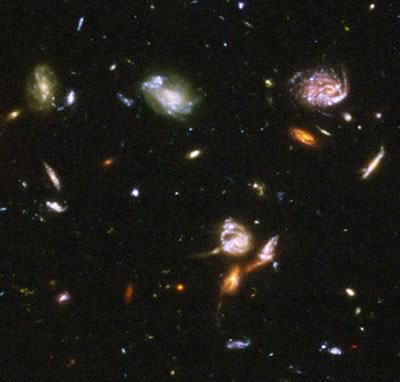How to fit a galaxy into an X-ray machine
When we look at a galaxy with our eyes, we see the stars inside that galaxy. But there are other components of galaxies, such as the gas which created the stars and planets (think oxygen for instance). We can not see this gas easily because it does not shine. But we can put the galaxy into an x-ray machine to see what it is made of.
One way to do this is to use the light from galaxies behind and calculate how much of the light it is absorbed. Such a good alignment of galaxies is pretty rare though, and you still don’t know how much absorption happened inside the galaxy behind.
 Instead, we use a special kind of supernovae, gamma-ray bursts, inside galaxies to x-ray galaxies. These stars explode and shine extremely bright across all wavelengths – including X-rays. That light is swallowed proportional to the material between us and the burst. If we know the original brightness we can measure how much gas, particularly the elements Oxygen and Iron, is between us and the burst (black line in the diagram on the right) – we made an X-ray of the galaxy! That is, if we have enough such explosions.
Instead, we use a special kind of supernovae, gamma-ray bursts, inside galaxies to x-ray galaxies. These stars explode and shine extremely bright across all wavelengths – including X-rays. That light is swallowed proportional to the material between us and the burst. If we know the original brightness we can measure how much gas, particularly the elements Oxygen and Iron, is between us and the burst (black line in the diagram on the right) – we made an X-ray of the galaxy! That is, if we have enough such explosions.
In this study we collected 1000 gamma-ray bursts observed with the Swift satellite, substantially more than past studies. By putting the X-ray machine inside the galaxy (that is, the gammar ray burst), we could measure the galaxy from the inside out. We found that galaxies with more stars have proportionally more gas. This may seem obvious, but current theoretical models of galaxies predict higher gas absorption in massive galaxies.
We see these extremely bright gamma-ray bursts out to very far distances. Therefore we can also study galaxies in the early Universe. For example, for some galaxies light reaches us only now but was sent at the time when Earth was formed. Learning about the Oxygen and Iron in those galaxies is important because those are the building blocks out of which rocky earth-like planets are made.
The study
Long Gamma-ray Bursts (LGRBs) are gamma-ray flashes that last longer than two seconds. They are thought to be caused by a kind of supernova from very massive stars. As the supernova explodes, material is thrown out and crashes with high velocities into the surrounding gas. This shock wave shines first in X-rays, then, as it cools down, in optical light, infrared and finally in radio wavelengths before it dims away.
In this study we use the X-ray emission of these bursts as bright beacons. We know how bright they were at the time of explosion, and we measure how much of that light was lost by gas absorbed in intervening clouds. Most of this absorption happens inside the galaxy where the burst went off, not in our galaxy or in the space between galaxies. This is a conclusion we reach because the absorption is correlated with host galaxy mass but not with distance to the galaxy. Where this absorption happens was heavily debated in the community though for the last decade.
 If you look at any Hubble image, you see that each galaxy is oriented differently then the next, some are face-on, some are edge-on, etc. That’s because our view point is not special, and galaxies just lie around the way they do. When we detect supernova explosions inside galaxies, their host galaxy is also randomly oriented. This allows us to sample all possible sight-lines through galaxies – some are short when the supernova was in the near side, some are longer as the light needs to pass through the entire galaxy. In our study we found that we can reproduce the distribution of absorption strength with a very simple model: Take an ellipsoid (a flattened sphere), place a light inside at a random position, and look at it from a random viewing angle, and measure how deep it is inside. If you do this often enough, the distribution of absorption strengths matches extremely well what we observe in our sample of 1000 measured absorption strengths to the LGRBs, and better than any previously proposed model.
If you look at any Hubble image, you see that each galaxy is oriented differently then the next, some are face-on, some are edge-on, etc. That’s because our view point is not special, and galaxies just lie around the way they do. When we detect supernova explosions inside galaxies, their host galaxy is also randomly oriented. This allows us to sample all possible sight-lines through galaxies – some are short when the supernova was in the near side, some are longer as the light needs to pass through the entire galaxy. In our study we found that we can reproduce the distribution of absorption strength with a very simple model: Take an ellipsoid (a flattened sphere), place a light inside at a random position, and look at it from a random viewing angle, and measure how deep it is inside. If you do this often enough, the distribution of absorption strengths matches extremely well what we observe in our sample of 1000 measured absorption strengths to the LGRBs, and better than any previously proposed model.
We measure absorption strengths of LGRBs by examining the X-ray spectra of each, as observed by the Swift satellite. The highly energetic radiation simply passes through all gas. But the less energetic radiation is partially absorbed if there is matter in between. Comparing the two gives use the absorption strength. Astronomers call this a column density, the number of atoms along the sight-line. Absorption/swallowing of X-ray photons primarily happens through ionisation of Oxygen and Iron atoms, so an electron is being launched out of the atom. Therefore what we measure is primarily the number of Oxygen and Iron atoms along the line-of-sight.
Finally we looked at a sample of galaxies were the mass was previously determined. This mass is that of all stars taken together — so not including gas. We found a highly significant, well-constrained relation between the mass and the absorption strength. This means that a more massive system holds more gas. This is not really surprising as Oxygen and Iron are expelled by stars, so the more stars, the more such gas should be there. Also, the more massive the galaxy, the better it is at holding that gas by gravitational pull. But our measurement allows us also to constrain the ratio of gas mass to stellar mass, which is approximately 1:30-1:100. This can be measured in nearby galaxies with other techniques. However this is the first time it is possible to measure that gas in very distant galaxies, simply because those explosions are so extremely bright.
- The first author of the study, Dr. Johannes Buchner, can be contacted for questions in English or German via jbuchner@astro.puc.cl
- This study has been published in MNRAS, the Monthly Notices of the Royal Astronomical Society, with the title “Galaxy gas as obscurer: I. GRBs x-ray Galaxies and find a NH³ = M* relation”.
- The authors of the study, Dr. J. Buchner, Dr. S. Schulze and Prof. F. E. Bauer are associated with the Institute of Astrophysics at the Pontificia Universidad Catolica de Chile.
- A pre-print of the paper can be accessed here: grbpaper.pdf
- Publication in MNRAS
Talks for researchers
Obscured Active Galactic Nuclei
In a second study we asked: What fraction of Active Galactic Nuclei are obscured by host galaxies? If galaxy gas can obscure GRBs, can this be an important effect why AGN are so frequently obscured?
- The first author of the study, Dr. Johannes Buchner, can be contacted for questions in English or German via jbuchner@astro.puc.cl
- This study has been submitted to MNRAS, the Monthly Notices of the Royal Astronomical Society, with the title “Galaxy gas as obscurer: II. Separating the nuclear and galaxy-scale obscuration of AGN”.
- A pre-print of the paper can be accessed here: agnpaper.pdf